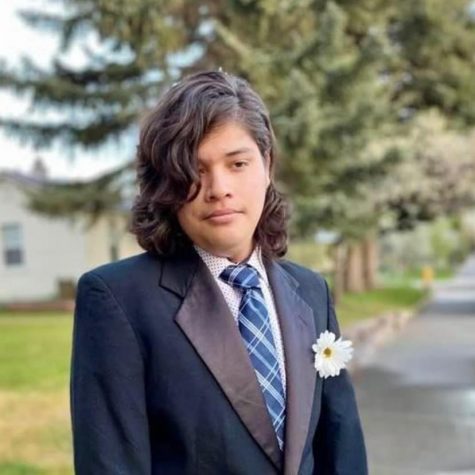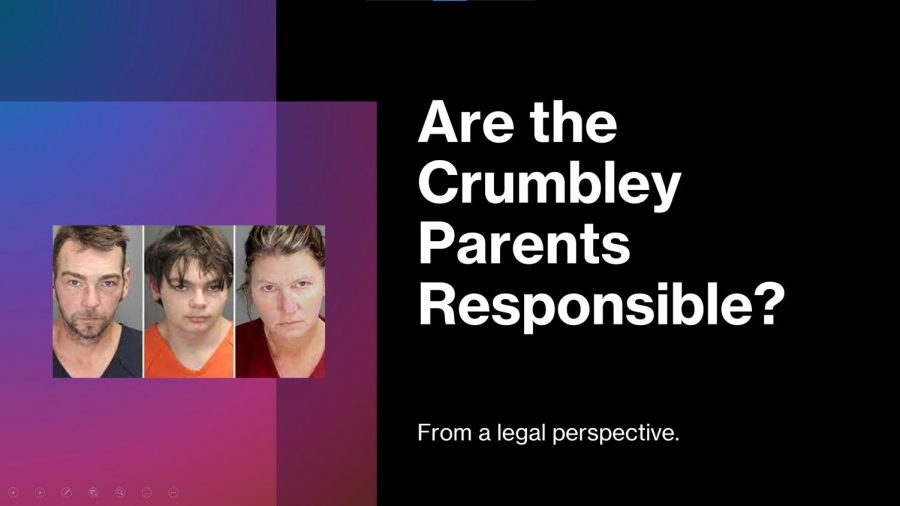Are the Crumbley Parents To Blame?
EDITOR’S NOTE: Stories that I write which pertain to law should NOT be used and considered as legal advice. I am not an attorney, nor can I give you legal advice. I am not licensed to practice law in my jurisdiction. Everything in this article is for informational and educational purposes only. All non-licensed material is used for fair use criticism and educational purposes.
By now you may have already heard about the terrible acts of Ethan Crumbley that occurred on November 30th, 2021 at Oxford High School in Michigan. It is the latest of many school shootings that have been happening in the United States this year. What is legally appealing, in this case, is in addition to filing murder charges against Ethan Crumbley, Oakland County prosecutor Karen McDonald has decided to charge Ethan’s parents James and Jennifer Crumbley with Involuntary Manslaughter. With this decision, McDonald broke with other prosecutors who have in the past declined to charge parents for the acts of a child. The question that’s being asked is “What if anything is different about this particular case, and does it signal a trend towards making parents more responsible for school shootings.”
The Charges.
As often in these cases, most people misunderstand the charges that were leveled against James and Jennifer Crumbley. These charges hinge on a more difficult legal question. “Could they have reasonably foreseen their son’s intentions?” As well as foreseeing the malicious intentions their teenage son would use the gun they purchased just to kill others. “Did they willfully disregard the results to others that might have to follow from their action or failure to act?” The prosecutor is arguing that the answer to these questions is yes. They knowingly armed a child who had emotional problems and when they were notified and warned by school administrators regarding the imminent danger when Ethan was searching for ammunition, his parents did not search his backpack nor did they take him home. The defense attorneys will likely argue that this isn’t the answer. The parents secured their guns and consulted with school administrators and everyone would reach the same conclusion that there was no risk that their son would take a gun out, and shoot others. Which is why Ethan was sent back to class. Millions of parents by proxy their children are armed in the United States. The defendant will likely claim that they had no way to know that this case would’ve been different compared to the several thousand cases that would result in an intentional homicide. The Oakland County prosecuting attorneys have filed Involuntary Manslaughter charges against Jennifer and James Crumbley, accusing them of failing to intervene on the day their son had killed four people despite the previous confrontations by the school.
What Lead Up to The Shooting.
According to the prosecutor on Black Friday, 15-year-old Ethan went to his father James to purchase a nine-millimeter. Ethan posted a photograph of the new gun on social media later that day. The post read “Just got my new beauty today. SIG SAUER 9mm. Ask any questions I’ll answer.” Jennifer Crumbley posted that the gun was a Christmas present, and had enjoyed a mother-son day at the range. The following day on November 29th, a teacher said that she saw a boy searching online for ammunition. Which prompted a meeting with school officials. School administrators had left a voicemail and had sent an e-mail to which Jennifer did not respond to the school. However, Mrs. Crumbley texted her son “lol I’m not mad at you. You have to learn not to get caught.” On Tuesday morning (Nov. 29th.) a teacher found a worksheet on Ethan’s desk and took a photo. It was a drawing of a gun pointing at the words “The thoughts won’t stop. Help me.” There was also a drawing of a bullet with text above that read “BLOOD EVERYWHERE.” There was a drawing of a person between the gun and the bullet that appears to have been shot twice. Ethan allegedly wrote, “My life is useless.” The teacher contacted the dean of the students and the school counselor. They called the Crumbleys for an emergency meeting at the school. Meanwhile, Ethan was placed in a counseling room with his backpack.
The Evidence
The counselor had obtained the drawing, but Eathen had already scratched out portions of it. He allegedly said the drawing was part of a video game that he was designing as he wanted a career in game development. Ethan stayed in the office for approximately 90 minutes working on an assignment for science. According to the Superintendent, the counselors didn’t believe that Ethan would harm anyone based on his demeanor. The Crumbleys arrived at the school around 10:30 am. School officials showed James and Jennifer the drawing. They asked Ethan whether he wanted to harm himself or others. Based on his answers, school officials and his parents assumed that he was not a threat. The Crumbleys resisted the idea that their son leaving campus and returning to an empty house. School officials told the parents to get Ethan into counseling within 48 hours.
The Shooting.
According to school Superintendent Tim Thorne, the school permitted Ethan to return to class because he had no disciplinary history. At about 12:51 pm, Ethan Crumbley emerged from a school bathroom with the gun his father had purchased days before. Crumbley fired at students in the hallways, killing four and wounding six students and one teacher. After the shooting made headlines across the nation, Jennifer texted Ethan Crumbley at 1:22 pm. “Ethan, don’t do it.” 15 minutes later, James calls 911 to report a gun was missing from his house, and he believed his son may be in possession of it. The Crumbleys stated that the gun was kept in a locked drawer located in the parent’s bedroom. James and Jennifer Crumbley aren’t being charged by virtue of being parents. Rather because of Ethan’s actions.
Types of Homicides in Michigan.
To understand the concept of this case, we must cover the different types of homicides in the state of Michigan. 1st Degree Murder is defined as “…perpetrated by means of poison, lying in wait, or any other willful, deliberate, and premeditated killing.” Premeditated in this context is defined as the person who thought about committing the murder before the act. This can take place for weeks or seconds before the action is carried out. An example of this would be Kierelle Burns, convicted of 1st Degree for luring his friend into an alleyway and purposely killing him. Burns stated he was acting on the orders of a business associate, but Burns created a plan for the murder ahead of time. This is an example of premeditation. Although this case is what comes to mind when premeditation is brought up, the term also applies to when someone quickly makes up their mind to kill someone within seconds. Ethan Crumbley has been charged with four counts of 1st Degree Murder, and several counts of Attempted Murder.
Another murder charge in Michigan is Manslaughter. In contrast, Manslaughter is murder without malice. As you may already know manslaughter offenses are not premeditated. Manslaughter is generally defined as the crime of killing a human being without malice aforethought, or otherwise in circumstances not amounting to murder. Michigan’s Criminal Statutes do not give a precise definition of Manslaughter. As a result, Michigan courts look to the common law to define traditional categories of Manslaughter. Such as Voluntary and Involuntary Manslaughter, In Michigan, Voluntary Manslaughter is often a “heat of passion.” This differs from 1st Degree Murder because the intent to kill was formed when the defendant had an irresistible passion caused by some sort of provocation. This provocation or excitement likely has to happen immediately without a chance for someone to settle down. If the person had enough time to stabilize their emotions and still proceed to kill another person, that is considered Murder.
Involuntary Manslaughter occurs during an accidental or non-intentional death in which the defendant had no cause of death. But their reckless act results in death. Involuntary Manslaughter can also happen during unlawful acts that are either a misdemeanor or low-level felony such as a DUI. (Keep in mind that this varies by state.) Perhaps a classic example of Involuntary Manslaughter is when someone drives under the influence and kills another person in a car accident. Other examples can be if someone lights a firework in a crowded space and someone is killed. You may not have any intentions of killing anyone, but a dangerous activity like this can result in death.
Requirements for Involuntary Manslaughter in Michigan.
Under Michigan law to convict someone of Involuntary Manslaughter, a prosecutor must prove beyond a reasonable doubt that the defendant caused the death of the victim, the victim’s death was the result of the defendant’s grossly negligent manner, and that the defendant caused the victim’s death without lawful excuse or justification. Proving someone’s acts or omissions caused someone else’s death is not an easy task. Especially so when those who were charged didn’t commit the physical acts that led to the death. So in this case, that means the prosecution has to prove that Ethan Crumbley’s intentional acts did not break the chain of causation that started when his parents purchased the firearm. The jury instruction on causation explains “It is not enough that the defendant’s acts made it possible for the death to occur. To find that death… was caused by the defendant, you must find a reasonable doubt that the death was the natural or necessary result of the defendant’s act.”
What Can Be Made of The Case?
The prosecutor can argue that Ethan easily obtained the weapon as a direct result of the parent’s actions. But that isn’t enough. The prosecutor will likely make the case that the Crumbleys failed to secure the gun. Or if it was prosecuted, it wasn’t secured properly. In the Crumbley’s defense, their attorneys may argue that the school didn’t warn the parents Ethan had threatened to use a firearm. That their only complaint was that he had made a drawing with violent imagery. Which isn’t common for young boys. While he was arguably fantasizing about killing, the school and parents concluded that he wasn’t a threat to himself or others. Ethan’s search for ammunition was simply nothing but a search. Attorneys may argue that given the short history of the entire family going to the shooting range that the most likely conclusion is that Ethan Crumbley was searching for ammunition to use at the range as they had done in the past. To prove the crime of Involuntary Manslaughter, the state has to prove that the family acted with Gross Negligence. Gross Negligence is defined as willfully disregarding the results of others that might follow from an act or failure to act. The prosecution must also prove that to a reasonable person, it would have been apparent that the result was likely to be a serious injury to another person. Assuming that the Crumbleys did not lock their gun, would that in itself constitute Gross Negligence? In most states, it is a crime to not properly store a firearm in the presence of a child. But Michigan does not have Child Access Prevention laws. These laws hold gun owners liable if guns are not adequately secured at home and away from children. That doesn’t mean it’s “unlawful” for the Crumbleys to carelessly store their firearm. Of course, not searching Ethan’s backpack under these circumstances is also a point of contention. This argument will likely be made as well. The Crumbleys allegedly didn’t find out that their firearm was missing until after the school shooting.
The Crumbleys Evading Arrest.
There is one issue that will hurt the Crumbleys defense, it is their attempt to evade arrest. When evidence was presented, the defendants attempted to escape after they were accusations were made. This can be used as evidence against the defendants in court as proof that they had consciousness of guilt. After the prosecutor announced that the parents would be charged, James and Jennifer withdrew $4,000 and hid in Detroit. The attorney for the Crumbleys stated that they were not fleeing from the police. They left town due to violence. Although their attorney said that the couple was preparing to turn themselves in, the circumstances of their capture aren’t in their favor. While the circumstances are still unusual, and no doubt will be difficult for prosecutors, there are some precedent factors when similar circumstances are taken into consideration. Some examples of this can be found in 2020. Jamelle James served two years in prison for leaving a pistol in a shoebox that his six-year-old nephew brought to school and used to fatally shoot a classmate. Other adults have been charged with Involuntary Manslaughter for not properly securing their guns. But prosecutors only tend to charge adults only when the shooter was young. That’s because the law only presumes that children at a young age cannot form criminal intent. But that isn’t the case for adolescents and teenagers who can form their criminal intent. Teens are presumed to have agency. This means the chain of causation between the adults and the homicide is usually broken.
What Can be Determined?
There’s no doubt that this is a tragic situation. Although this was a tragedy, to say the least, prosecuting attorneys have high standards to meet for statutes in Michigan. From a legal perspective, this case covers complicated circumstances and laws that might not seem relevant in today’s society. With so many shootings taking place in the U.S. architects have taken into account what security measures can be implemented. Materials such as automatic LED-edge-lit glass gates and stainless steel now can be customized with different materials to match the building’s design aesthetic. But time will tell if these preventative measures are effective.

My name is Diamond. I just graduated high school and now I'm producing content part-time online. My most popular profile is @BlindOS_22 on TikTok which...













